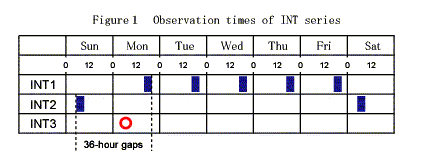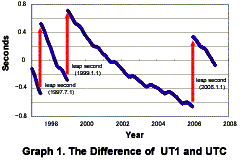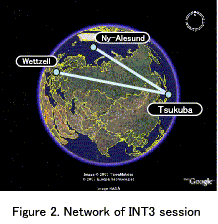|
||||||||
| |
|
|
|
|
||||
|
||||||||
| |
|
|
|
|
||||
|
Implemention of Intensive INT3 Session 〜Rapid determination of UT1 (Earth's rotation speed) by quasi-real time e-vlbi〜 |
|
|
Tsukuba32m antenna will perform Intensive INT3 Session for rapid determination of UT1 every monday. |
|
|
What is INT session ?
|
|
INT("Intensive") session is one of VLBI sessions scheduled by International VLBI Service for Geodesy and Astrometry.
The purpose is that we rapidly and high frequency(every day) determine UT1 estimates by performing "intensive" observations on about one hour session.
Previously, The following two series has been performed.
|
|

|
|
| UT1 determination by VLBI | |
 The Earth rotates once a day, but its rotation speed are not constant, disturbed by lunar gravity and various dynamic phenomena of the Earth.
Using far distant celestial as target, VLBI is one of the few techniques that can obtain the estimates of Earth's rotation and orientation, especially Earth rotation parameter which GPS cannnot determine is determined by VLBI observation.
These informations is necessary for performing orbit control satelites and space craft, including GPS, so rapidly and precisely determinations of the parameter are required.
The Earth rotates once a day, but its rotation speed are not constant, disturbed by lunar gravity and various dynamic phenomena of the Earth.
Using far distant celestial as target, VLBI is one of the few techniques that can obtain the estimates of Earth's rotation and orientation, especially Earth rotation parameter which GPS cannnot determine is determined by VLBI observation.
These informations is necessary for performing orbit control satelites and space craft, including GPS, so rapidly and precisely determinations of the parameter are required.The right graph compares the time based on the Earth rotation determined by VLBI(Universal Time:UT1) to the time based on precise atomic clocks which is used in daily life. It shows that Earth rotations are not constant but inconstant. |
|
|
Detailed INT3 sessions
|
|
 There are 36-hour gaps in the data series between the INT1 and INT2 Intensive sessions.
The one of the goal of INT3 session is to fill the gap and high-frequency UT1 determination. (figure 1)。
In INT3 session, we aim to obtain the UT1 estimate in 24 hours after the session. we adapt "eVLBI" for the purpose.
Tsukuba station(Japan), Ny-Alesund station(Norway) and Wettell station(Germany) is selected as participating station to INT3 session.
These stations installs high-speed network for eVLBI.
There are 36-hour gaps in the data series between the INT1 and INT2 Intensive sessions.
The one of the goal of INT3 session is to fill the gap and high-frequency UT1 determination. (figure 1)。
In INT3 session, we aim to obtain the UT1 estimate in 24 hours after the session. we adapt "eVLBI" for the purpose.
Tsukuba station(Japan), Ny-Alesund station(Norway) and Wettell station(Germany) is selected as participating station to INT3 session.
These stations installs high-speed network for eVLBI.
Ny-Alesund, Wettzell and Tsukuba will perform the observation and will transfer the observated data to Bonn colerator with quasi-real time by using eVLBI. "Tsunami" protocol will adapt for the purpose. The protocol adapts UDP protcol and it was originally developed by Indiana University. In a previous transfer test, we achieved avarage data rates of about 275Mbps. It means that we can transfer all data of one session(about 50 Gbyte) within about 24 minutes. We performed INT3 test session on June 19 and August 13, 2007. We solved the probrem of the test and have performed INT3 session since August 27(Monday). |
|